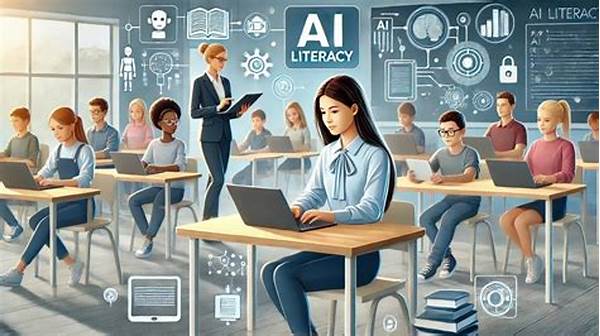In today’s fast-paced world, where technology advancements are at the epicenter of every industry, there’s a growing discussion about why AI basics should be taught in schools. With artificial intelligence interweaving into the fabric of everyday life, it’s crucial for today’s generation to grasp the fundamental concepts of AI from an early age. But why should we care, and what’s the big deal about introducing AI to the school curriculum? Buckle up, folks, as we delve into a story of why embracing AI education is not just beneficial but essential.
Read More : Beginner Resources To Learn Ai
Imagine a school where instead of traditional homework, students are tasked with creating a simple AI project. Sounds intimidating? Sure. But, imagine the sense of accomplishment and excitement these kids would feel when they successfully train their AI to identify images of their favorite superheroes! It’s not about turning everyone into a computer scientist; it’s about demystifying AI and sowing the seeds of curiosity and innovation. Let’s face it, AI is not some faraway concept reserved for science fiction. It’s here, and it’s shaping industries, job markets, and even the way we conduct our daily routines.
No longer just an abstract idea, artificial intelligence plays a significant role in various sectors. From healthcare to finance, AI is revolutionizing the way businesses operate, making processes more efficient and decisions more data-driven. Adding AI basics to school curricula prepares students for an AI-impacted job market. According to a 2022 study by McKinsey, AI technologies could potentially automate up to 30% of tasks in about 60% of all occupations. Knowledge of AI, therefore, offers a competitive edge to young learners in their future careers.
Having AI as a part of early education also fosters critical thinking and problem-solving skills. When kids learn the basics of AI, they learn how to approach problems from different angles, break them down into manageable parts, and find creative solutions. These are essential life skills, applicable far beyond technology. The logical thinking required to understand AI can, in fact, contribute to a better understanding of subjects like math, science, and even art, bringing an interdisciplinary approach to education.
Integrating AI in Our Education System
As we advocate for why AI basics should be taught in schools, let’s explore how we can make this happen. One step could be integrating AI modules within existing subjects. Coding, for example, can include simple AI principles. Science classes could demonstrate the practical applications of AI in conducting experiments or analyzing data. The approach to AI education does not have to be a standalone unit; it can be cleverly woven into existing subjects, providing a rich, engaging, and comprehensive learning experience.
—
Structure for AI in School Curriculum
Initiating the AI Education Revolution
The demand for AI education isn’t a mere trend; it’s an urgent call to action. Understanding AI isn’t just about mastering an emerging technology—it’s about comprehending a critical component of our modern world. As technology evolves, so too must our educational approaches. Schools are no longer solely about reading, writing, and arithmetic. Academic success now involves an understanding of digital literacy and artificial intelligence, and here’s why AI basics should be taught in schools.
The integration of AI education in school syllabuses is akin to introducing a new language—a language increasingly spoken in all professional fields. By introducing students to AI, we’re not just preparing them for careers in tech but offering them the tools they need to interact with a world dominated by technology. According to a 2023 study by the World Economic Forum, 65% of children entering primary school today will work in jobs that currently do not exist. Why AI basics should be taught in schools becomes glaringly important in this context.
Framework for Implementing AI Basics
Creating a structure for including AI education in schools is not a Herculean task. By developing age-appropriate modules, educators can introduce AI concepts as early as in elementary schools. Starting with simplified AI models and visual tools can make complex concepts digestible for young minds. Progressively, as students advance, more intricate computational theories and hands-on projects can be introduced.
Incorporating AI education isn’t about replacing traditional subjects but complementing them. Mathematics, for example, plays a pivotal role in understanding algorithms, while language skills assist in comprehending system commands and outputs. By connecting AI with existing disciplines, we emphasize AI’s multifaceted relevance and application.
Overcoming Challenges in AI Education
Despite its importance, there are hurdles to the widespread adoption of AI education. Limited resources, scarcity of trained educators, and the initial cost of technology present significant challenges. However, partnerships between schools and tech organizations can mitigate these issues. Initiatives such as teacher training programs, AI education grants, and collaboration with AI experts in workshops can catalyze this transformation.
Community engagement also plays a vital role in popularizing AI education. By fostering a collaborative atmosphere involving students, parents, teachers, and AI professionals, we create a nurturing environment that supports learning beyond the classroom. This communal effort ensures that AI education is not only theoretical but also practical and impactful.
Discussion Points: Why AI Basics Should Be Taught in Schools
Goals in Teaching AI Basics in Schools
In conclusion, the main goal of teaching AI basics in schools is to prepare students for an increasingly AI-driven world. Why AI basics should be taught in schools is a question that echoes in the minds of educators, policymakers, and industry leaders alike. AI literacy among students ensures they are more likely to thrive in the workforce, equipped with the understanding necessary to navigate and utilize AI responsibly and ethically.
Moreover, exposing students to the fundamentals of AI encourages innovation and critical thinking. These skills are crucial not only in computer science but also in solving real-world problems across various domains. When we speak of future leaders, we envision individuals capable of leveraging AI to spearhead advancements in fields such as healthcare, climate change, and education itself.
Finally, teaching AI basics opens up endless possibilities for students, breaking barriers of entry into STEM fields and beyond. By bridging the digital divide at the educational level, we empower all students, regardless of background, to engage with technology not just as passive users but as active creators. The message is clear: AI education is not just a perk for the privileged; it’s a necessity for all.
The Case for AI in Our Classrooms
The Groundswell of AI Curriculum
AI education is indeed becoming a cornerstone of modern learning. As education systems worldwide move forward, the question of why AI basics should be taught in schools persists, persisting as a rallying call for educational reform. The necessity for AI education in schools stems not just from a technical need but a societal one. With the world increasingly reliant on AI, educators have a responsibility to ensure students are well-prepared for the challenges and opportunities that lie ahead.
Building a curriculum that integrates AI requires more than just exposure; it requires a commitment to ongoing development. As AI evolves, so should the educational frameworks that teach its principles. Continuous professional development for teachers, adaptable teaching resources, and regular curricular reviews ensure that AI education remains relevant and comprehensive.
In summary, the conversation surrounding AI in education is not merely academic—it’s pivotal. AI is no longer just an asset to learn about; it’s a society-defining technology. Why AI basics should be taught in schools is a pressing inquiry, demanding answers and action to prepare our youth to confidently step into an AI-integrated world. It’s time to act and integrate artificial intelligence into the heart of education to drive innovation, enhance learning, and build a future-ready generation.
I hope you find this exploration into the benefits and structure of teaching AI in schools insightful. If you have any questions, need further exploration of the topic, or require additional assistance, feel free to reach out!



